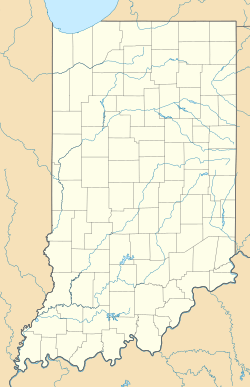Yankeetown Site facts for kids
Quick facts for kids |
|
|
Yankeetown Archeological Site
|
|

Eastern portion of the site
|
|
| Location | Along the Ohio River bank in Section 21 of Anderson Township, south of Yankeetown, Indiana |
|---|---|
| Area | 140 acres (57 ha) |
| NRHP reference No. | 79000026 |
| Added to NRHP | February 28, 1979 |
The Yankeetown Site (also known as 12W1) is a very important archaeological site located along the Ohio River in the southwestern part of Indiana. An archaeological site is a place where people lived a long time ago, and we can find clues about their lives.
This site was home to people during the prehistoric Woodland period, which was a time before Europeans came to America. The Yankeetown Site has given us a lot of information about these ancient people. However, the site has been damaged over time by the river. Even with the damage, it has been recognized as a special historic site for over thirty years.
Contents
Where is the Yankeetown Site Located?
The Yankeetown Site is mostly found in a small area called Section 21 of Anderson Township in Warrick County. This section is a small triangle right by the Ohio River.
The modern town of Yankeetown is about 1.5 miles north of the site. A road goes from the town down to the river. The main part of the site stretches along the riverbank for about 0.75 miles from where the road meets the river.
River Erosion at Yankeetown
The riverbank part of the site has been greatly damaged by erosion. Erosion happens when the river slowly wears away the land. In 1950, people who owned land along the river said that about 20 feet of the bank were washed away every year! This means parts of the ancient site are lost to the river.
What Have Archaeologists Found at Yankeetown?
In April 1950, a famous archaeologist named Glenn Albert Black visited Yankeetown with three friends. They carefully looked at the site and started to list the artifacts they found. Artifacts are objects made or used by people in the past.
Because of the heavy erosion, they could see things like ancient pits and hearths (old fireplaces). They found many artifacts, including small clay pieces, bits of charcoal, and burned clay.
Four months later, another group explored the site. They found a layer of daub about 8 inches below the surface. Daub is a mix of clay, mud, and straw used to build walls. This layer was important because it was made of burned pieces, grass, and weeds. It also had a dip that might have been where a house once stood.
Special Artifacts from Yankeetown
Many of the artifacts found at Yankeetown are kept in a museum. This museum is at Angel Mounds State Memorial in Evansville, which is nearby. Some findings from the second 1950 survey were kept separate, and the landowner also had a large collection.
More than six thousand sherds from Yankeetown are at the Angel Mounds museum. Sherds are broken pieces of pottery. Most of the pottery pieces found in 1950 had been mixed with clay or grit to make them stronger. About six hundred pieces had shell mixed in, and only about five hundred had no extra material added.
Many of the pottery pieces are plain. Hundreds have been found with cord marks or carved designs. However, about 64% of the pottery known in 1950 had no decoration at all.
Rarer items found at Yankeetown include:
- Flint knives
- Hammerstones (stones used for hammering)
- Trowels (tools for shaping clay)
- Lithic flakes (small pieces of stone chipped off when making tools)
- Animal bones
- Objects made of cannel coal
- Two damaged pottery effigies (small statues) of women. These statues were broken below the shoulders.
What We Learned from Yankeetown
The second survey in 1950 named Yankeetown the type site for a special kind of pottery. This pottery had both raised designs (called appliqué) and carved lines (called incision). When this type of pottery was found in other places, it was called "Yankeetown fillet" or "Yankeetown incised."
Objects similar to those from Yankeetown have been found far away. They have been discovered north of Vincennes, Indiana along the Wabash River, at the Great Salt Spring in Gallatin County, Illinois, and near St. Louis.
The Yankeetown culture seems to be connected to another group called the Duffy Complex. The Duffy Complex is known from sites near the mouth of the Wabash River. Both Yankeetown and Duffy artifacts have been found at the Great Salt Spring. However, scientists are still working to understand exactly how these two groups are related.
Protecting the Yankeetown Site
It has been hard to protect the Yankeetown Site because of the river's erosion. However, keeping the artifacts safe in the Angel Mounds museum has helped save information about the site.
To help protect the site even more, the Yankeetown Site was added to the National Register of Historic Places in 1979. This is a list of important historical places in the United States. It is one of eight places in Warrick County on this list. Other sites include part of the Angel Mounds State Memorial and the nearby Caborn-Welborn Mississippian site, called the Ellerbusch Site.
Images for kids




